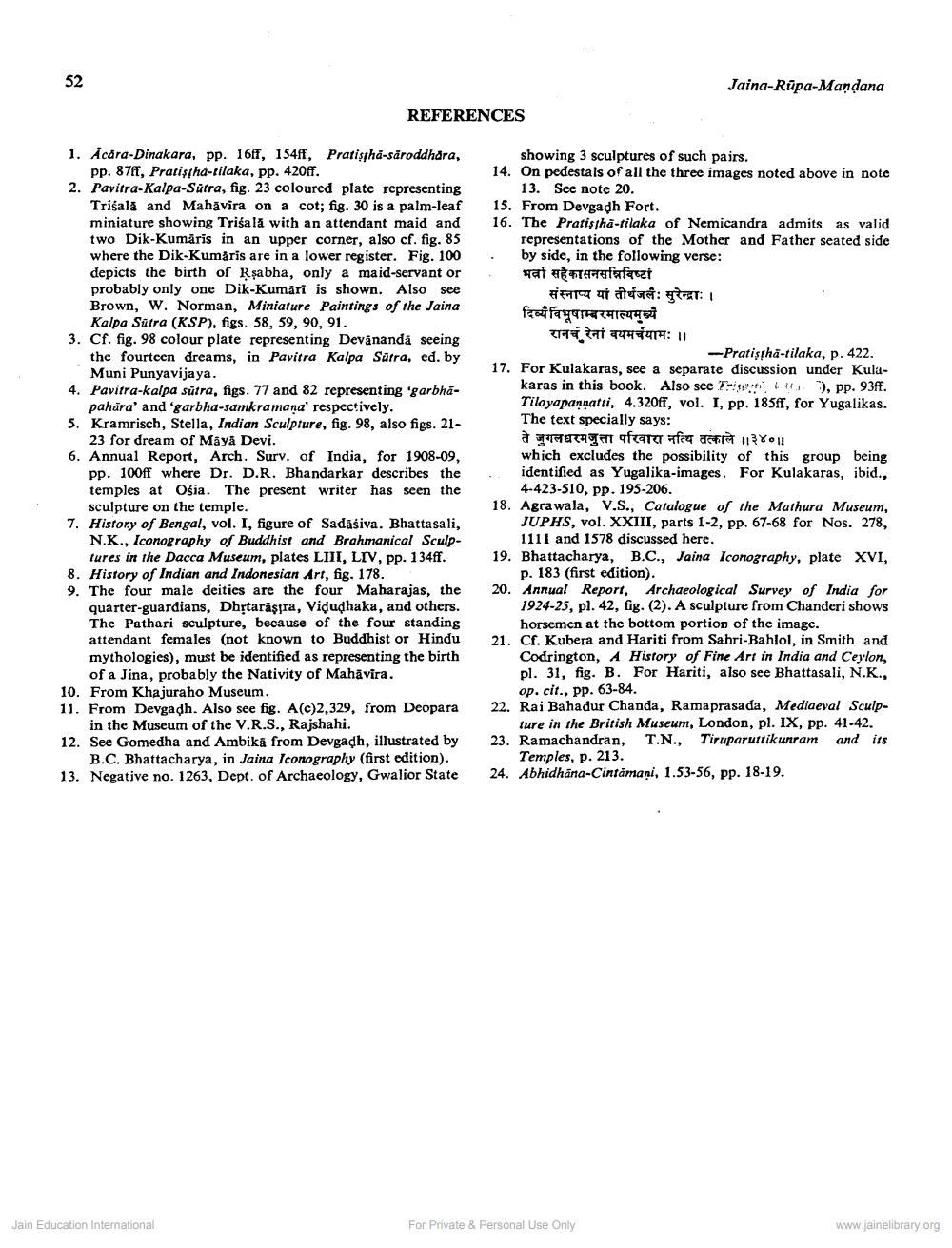________________
Jaina-Rūpa-Mandana
REFERENCES
1. Acara-Dinakara, pp. 16ff, 154ff, Pratisha-säroddhara,
pp. 87ff, Pratisthå-tilaka, pp. 420ff. 2. Pavitra-Kalpa-Satra, fig. 23 coloured plate representing
Trišala and Mahavira on a cot; fig. 30 is a palm-leaf miniature showing Trišală with an attendant maid and two Dik-Kumāris in an upper corner, also cf. fig. 85 where the Dik-Kumaris are in a lower register. Fig. 100 depicts the birth of Rşabha, only a maid-servant or probably only one Dik-Kumāri is shown. Also see Brown, W. Norman, Miniature Paintings of the Jaina
Kalpa Sutra (KSP), figs. 58, 59, 90, 91. 3. Cf. fig. 98 colour plate representing Devananda seeing
the fourteen dreams, in Pavitra Kalpa Satra, ed. by
Muni Punyavijaya. 4. Pavitra-kalpa sutra, figs. 77 and 82 representing 'garbha
pahāra' and 'garbha-samkramana' respectively. 5. Kramrisch, Stella, Indian Sculpture, fig. 98, also figs. 21
23 for dream of Maya Devi. 6. Annual Report, Arch. Surv. of India, for 1908-09,
pp. 100ff where Dr. D.R. Bhandarkar describes the temples at Osia. The present writer has seen the
sculpture on the temple. 7. History of Bengal, vol. I, figure of Sadāśiva. Bhattasali,
N.K., Iconography of Buddhist and Brahmanical Sculp
tures in the Dacca Museum, plates LIII, LIV, pp. 134ff. 8. History of Indian and Indonesian Art, fig. 178. 9. The four male deities are the four Maharajas, the
quarter-guardians, Dhrtarăşira, Vidudhaka, and others. The Pathari sculpture, because of the four standing attendant females (not known to Buddhist or Hindu mythologies), must be identified as representing the birth
of a Jina, probably the Nativity of Mahāvira. 10. From Khajuraho Museum. 11. From Devgadh. Also see fig. A(c)2,329, from Deopara
in the Museum of the V.R.S., Rajshahi. 12. See Gomedha and Ambika from Devgadh, illustrated by
B.C. Bhattacharya, in Jaina Iconography (first edition). 13. Negative no. 1263, Dept. of Archaeology, Gwalior State
showing 3 sculptures of such pairs. 14. On pedestals of all the three images noted above in note
13. See note 20. 15. From Devgadh Fort. 16. The Pratisha-tilaka of Nemicandra admits as valid
representations of the Mother and Father seated side by side, in the following verse: भर्वा सहकासनसन्निविष्टां
संस्नाप्य यां तीर्थजलैः सुरेन्द्राः । दिव्य विभूषाम्बरमाल्यमुख्य रानचं रेनां वयमर्चयामः ।।
--Pratisha-tilaka, p. 422. 17. For Kulakaras, see a separate discussion under Kulu
karas in this book. Also see T- 110 , pp. 93ff. Tiloyapannatti, 4.320ff, vol. I, pp. 185ff, for Yugalikas. The text specially says: ते जुगलधरमजुता परिवारा नत्थि तत्काले ॥३४०॥ which excludes the possibility of this group being identified as Yugalika-images. For Kulakaras, ibid.,
4-423-510, pp. 195-206. 18. Agrawala, V.S., Catalogue of the Mathura Museum,
JUPHS, vol. XXIII, parts 1-2, pp. 67-68 for Nos. 278,
1111 and 1578 discussed here. 19. Bhattacharya, B.C., Jaina Iconography, plate XVI,
p. 183 (first edition). 20. Annual Report, Archaeological Survey of India for
1924-25, pl. 42, fig. (2). A sculpture from Chanderi shows
horsemen at the bottom portion of the image. 21. Cf. Kubera and Hariti from Sahri-Bahlol, in Smith and
Codrington, A History of Fine Art in India and Ceylon, pl. 31, fig. B. For Hariti, also see Bhattasali, N.K.,
op. cit., pp. 63-84. 22. Rai Bahadur Chanda, Ramaprasada, Mediaeval Sculp
ture in the British Museum, London, pl. IX, pp. 41-42. 23. Ramachandran, T.N., Tiruparuttikunram and its
Temples, p. 213. 24. Abhidhāna-Cintamani, 1.53-56, pp. 18-19.
Jain Education International
For Private & Personal Use Only
www.jainelibrary.org




